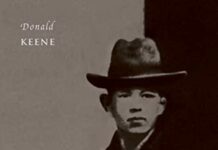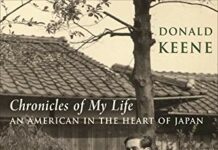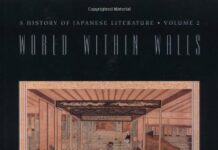
Ebook Info
- Published: 2005
- Number of pages: 127 pages
- Format: PDF
- File Size: 0.66 MB
- Authors: Donald Keene
Description
The New Yorker has called Donald Keene “America’s preeminent scholar of Japanese literature.” Now he presents a new book that serves as both a superb introduction to modern Japanese fiction and a memoir of his own lifelong love affair with Japanese literature and culture. Five Modern Japanese Novelistsprofiles five prominent writers whom Donald Keene knew personally: Tanizaki Jun’ichiro, Kawabata Yasunari, Mishima Yukio, Abe Kobo, and Shiba Ryotaro. Keene masterfully blends vignettes describing his personal encounters with these famous men with autobiographical observations and his trademark learned literary and cultural analysis. Keene opens with a confession: before arriving in Japan in 1953, despite having taught Japanese for several years at Cambridge, he knew the name of only one living Japanese writer: Tanizaki. Keene’s training in classical Japanese literature and fluency in the language proved marvelous preparation, though, for the journey of literary discovery that began with that first trip to Japan, as he came into contact, sometimes quite fortuitously, with the genius of a generation. It is a journey that will fascinate experts and newcomers alike
User’s Reviews
Reviews from Amazon users which were colected at the time this book was published on the website:
⭐This small book about FIVE MODERN JAPANESE NOVELISTS by Donald Keene, who had opportunities to make more observations about them than anyone could possibly remember in the years during which he became aware of their work, met them, read their books, wrote about or tried to put their words into English (Supplemental readings at the end include the titles of his major history of Japanese literature, DAWN TO THE WEST, and his translations of AFTER THE BANQUET, FIVE MODERN NO PLAYS, and MADAME DE SADE by Mishima Yukio, and translations of FRIENDS, THE MAN WHO TURNED INTO A STICK, and THREE PLAYS by Abe Kobo). Keene is so familiar with the word order used for Japanese names that it shows up in the oddest places. Maybe this is for humor, which always seems to be welcome at Columbia University:”I first met Abe Kobo in the autumn of 1964. He had come to New York . . . With them came a young Japanese woman. I confess that I was rather miffed when I was informed that the young woman was their interpreter, and in order to demonstrate that I had no need of an interpreter, I studiously avoided even looking at her. It was only years later that I learned that she was Ono Yoko.” (p. 65).These people are all so smart, it even seems funny that they have so much trouble fitting in, as when Abe graduated from medical school “in 1948 but was given his degree only on condition that he never practice medicine;” (p. 74). Early in the book, Keene has a few details about being “at the U.S. Navy’s Japanese-language school” (pp. 2-3) and getting some early practice “while in Hawaii during the war, I had read his novel NAOMI” (p. 1). Then in 1951 an English translator gave Keene the three Japanese volumes of THE MAKIOKA SISTERS by Tanazaki Jun’ichiro (1886-1965).This book has an index, and you can look up Nobel Prize for Literature and find out that Kawabata Yasunari (1899-1972) won it in 1968, but it might be politically selective, because “he had served since 1948 as president of the Japanese PEN Club,” (p. 23). A news report that Tanazaki Jun’ichiro had won the Prize in 1964 “was a mistake, and by the time Japan’s turn at last came up in this geographically controlled competition, Tanizaki was dead.” (p. 24). Keene would also like you to know, “What prevented Mishima from obtaining the prize?” (p. 25). How many Swedes could think Mishima was a young leftist (some secret committee would expect that to be a bad choice) instead of a right-wing nationalist who would end it all with seppuku on November 25, 1970? Keene was more aware of the political situation in Japan because “In June 1970, on the night the security treaty with the United States came up for renewal, I was in a taxi with Mishima” (p. 46). And the opening sentence of the last letter Mishima sent to Keene was “When you read these words I shall be dead.” (p. 48).The final Japanese author to get a chapter in this book, Shiba Ryotaro (1923-1996) worked as a reporter. Keene had not yet met him in 1971 and should have been suspicious when an editor told him that he would like to publish a dialogue, and that when Shiba was “told that I was unfamiliar with his writings, had insisted that I was not to read them. This gracious concession made it impossible for me not to take part in the dialogue.” (p. 86). Shiba turned it into a book in which he said they had been “comrades in arms” (p. 87) because they had both served in the same war. Shiba wrote travel books and historical fiction. Though not popular in the rest of the world, “His writings inspired a whole country, not with patriotic zeal, but with a quiet awareness of what being Japanese has meant through history.” (p. 99).It is a bit surprising that the early parts of this book make World War II seem like a much bigger catastrophe for the Japanese than the index, which only has entries for “war, 40, 72, 87.” (p. 113). Kawabata Yasunari served as an air-raid warden, enduring “the cold of the night and feel my own sadness melt into the sadness of Japan. I felt there was a beauty that would perish if I died. My life did not belong to me alone.” (p. 41). Mishima Yukio had a cold the day he reported for his physical examination, but “when the inexperienced young doctor asked if he always had a fever and coughed so much, he nodded gravely. His cold was diagnosed as pleurisy, and he was sent home the same day, to his joy and relief.” (p. 51). Sick, sick, sick! “Abe entered the Tokyo University Medical School in 1943, at the age of nineteen. This gave him temporary exemption from the draft, but in the following year his unsatisfactory scholastic performance endangered the exemption.” (p. 72). “At first he helped his father with his medical practice, but in August 1945, just before the end of the war, a typhus epidemic swept Manchuria and the father caught the sickness and died. Abe remained in Mukden.” (pp. 72-73).”In my case, as Shiba mentioned, it was because of the war that I had learned Japanese, and this would be at once my lifework and the factor that made it possible for Shiba and me to become friends. In his case (though he did not mention it at the time) the war had aroused a hatred for the nationalism that had been its cause. Our wartime experiences had been entirely different, but they had brought us to the same place.” (p. 87).The book descriptions were better than the war; much more pleasant.
⭐Donald Keene recalled his friendship with representative modern Japanese writers. He extends interpretation and critical thoughts about them and their works. His comments inspire us and the readers are encouraged to read these works. Keene’s writing is not only precise and vividly describing how these writers are, but also a beautiful writing by itself.
⭐
Keywords
Free Download Five Modern Japanese Novelists in PDF format
Five Modern Japanese Novelists PDF Free Download
Download Five Modern Japanese Novelists 2005 PDF Free
Five Modern Japanese Novelists 2005 PDF Free Download
Download Five Modern Japanese Novelists PDF
Free Download Ebook Five Modern Japanese Novelists




